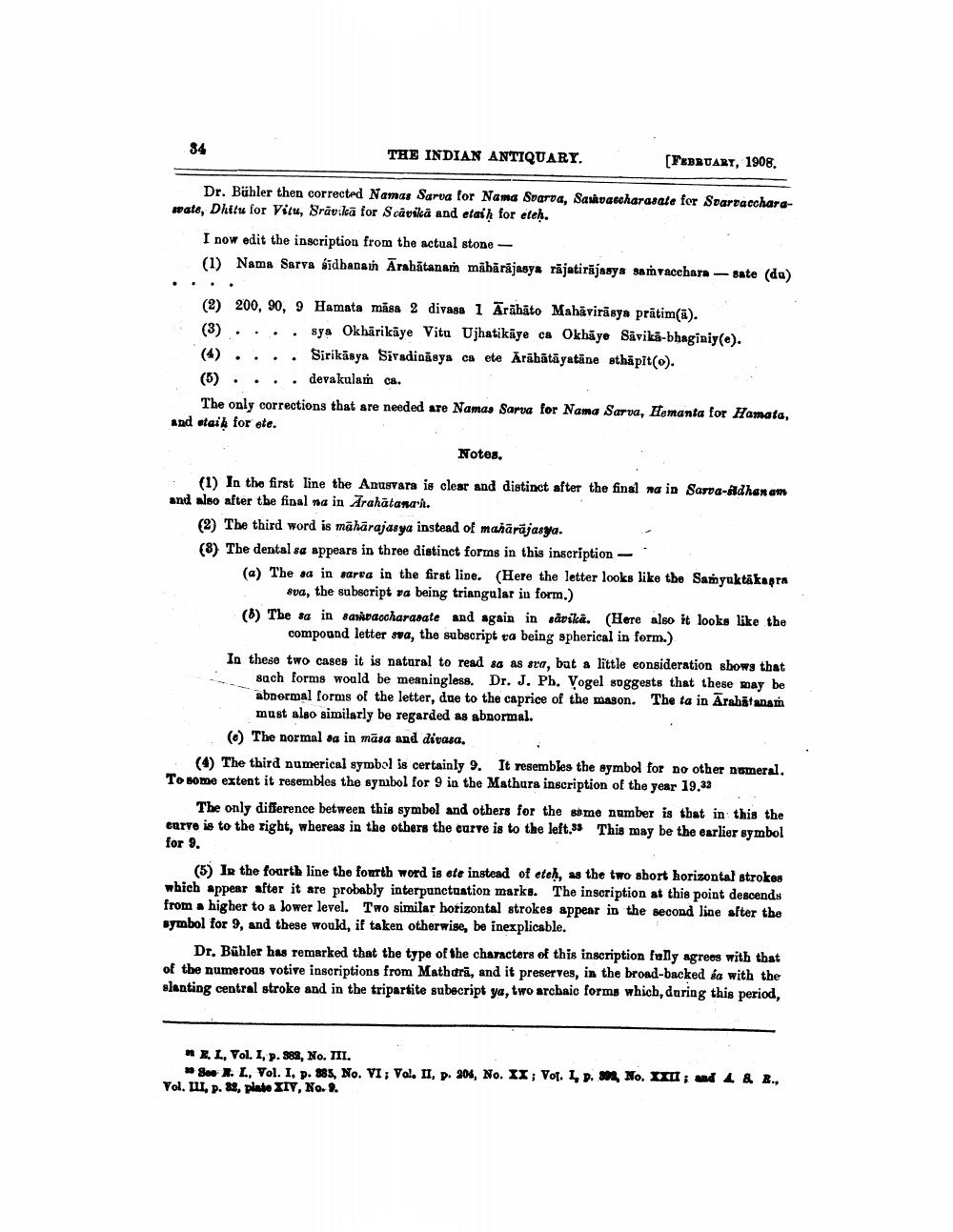________________
34
THE INDIAN ANTIQUARY.
[FEBRUARY, 1908.
Dr. Bühler then corrected Namas Sarva for Nama Svarva, Sasvaecharasate for Svarvaccharawate, Dhitu for Vitu, Sravika for Scävikä and etaiḥ for eteḥ.
I now edit the inscription from the actual stone
(1) Nama Sarva Sidhanai Arahātanaṁ māhārājasya rājatirājasya saṁvacchara
sate (da)
(2) 200, 90, 9 Hamata masa 2 divasa 1 Arahato Mahavirasya pratim(ā). (3) sya Okharikaye Vitu Ujhatikaye ca Okhaye Savika-bhaginiy(e). Sirikasya Sivadinasya ca ete Arāhātāyatāne sthāpīt(o). devakulam ca.
(4)
(5)
The only corrections that are needed are Namas Sarva for Nama Sarva, Hemanta for Hamata, and staiḥ for ete.
Notes.
(1) In the first line the Anusvara is clear and distinct after the final na in Sarva-dhanam and also after the final na in Arahātanah.
(2) The third word is maharajasya instead of mahārājasya.
(8) The dental sa appears in three distinct forms in this inscription -
(a) The sa in sarea in the first line. (Here the letter looks like the Samyuktākaşra sva, the subscript va being triangular in form.)
(8) The sa in savaccharasate and again in sävikä. (Here also it looks like the compound letter sva, the subscript va being spherical in form.)
In these two cases it is natural to read sa as sea, but a little consideration shows that sach forms would be meaningless. Dr. J. Ph. Vogel suggests that these may be abnormal forms of the letter, due to the caprice of the mason. The ta in Arahātanam must also similarly be regarded as abnormal.
(6) The normal sa in masa and divasa.
(4) The third numerical symbol is certainly 9. It resembles the symbol for no other numeral. To some extent it resembles the symbol for 9 in the Mathura inscription of the year 19,33
The only difference between this symbol and others for the same number is that in this the earve is to the right, whereas in the others the curve is to the left.33 This may be the earlier symbol for 9.
(5) In the fourth line the fourth word is ete instead of eteḥ, as the two short horizontal strokes which appear after it are probably interpunctuation marks. The inscription at this point descends from a higher to a lower level. Two similar horizontal strokes appear in the second line after the symbol for 9, and these would, if taken otherwise, be inexplicable.
Dr. Bühler has remarked that the type of the characters of this inscription fully agrees with that of the numerous votive inscriptions from Mathura, and it preserves, in the broad-backed sa with the slanting central stroke and in the tripartite subscript ya, two archaic forms which, during this period,
E. L., Vol. I, p. 382, No. III.
"See R. L., Vol. I, p. 885, No. VI; Vol. II, p. 204, No. XX; Vol. 1, p. 392, No. XXII; and A. & R., Vol. III, p. 88, plate XIV, No. 9.




